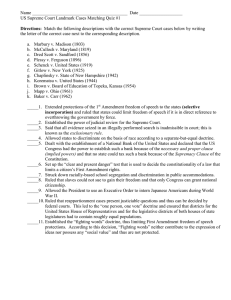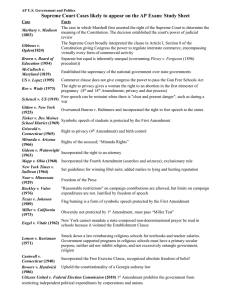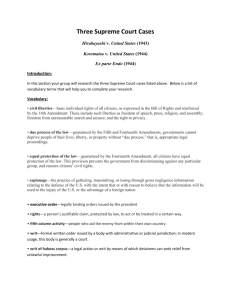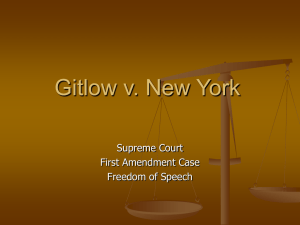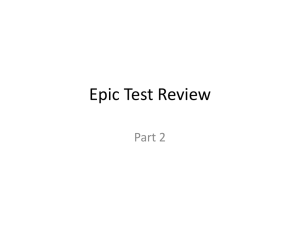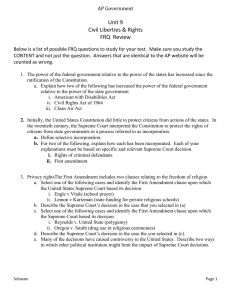Chapter 4 Civil Liberties and Public
advertisement
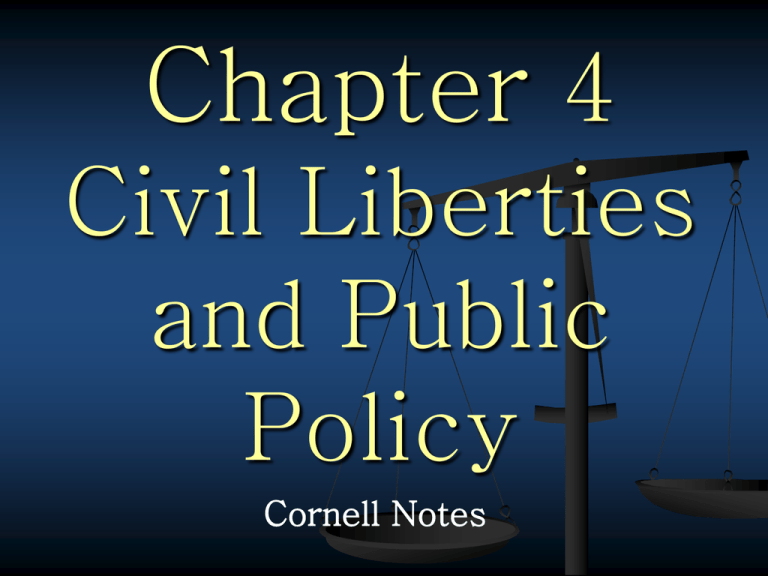
Chapter 4 Civil Liberties and Public Policy Cornell Notes Topic / Main Ideas Details I. Introduction A. Key Terms B. The Bill of Rights 1. Civil Liberties Are legal and constitutional rights that protect individuals from arbitrary acts of government Include freedom of speech, religion, press, guarantees a right to a fair trial (Amendments 1-8) 2. Civil Rights Are policies designed to protect people against arbitrary or discriminatory treatment by government officials or individuals Include laws against racial and gender discrimination • Originally not included in the Constitution. States already had their own. • Pushed by the anti-federalist to add a list of safeguards to protect basic rights and freedoms. Topic / Main Ideas Details Questions and Summary Questions 1. Civil liberties consist of A) legal and constitutional protections against the government. B) the right to be treated equally under the law. Summary _______________________________________________________________ _______________________________________________________________ _______________________________________________________________ _______________________________________________________________ Topic / Main Ideas Details II. The Bill of Rights and the States A. The Scope of the Bill of Rights Barron v. Baltimore B. The 14th Amendment 1. The Bill of Rights intended to restrict the federal government 2. In Barron v. Baltimore (1833), the Court ruled that the Bill of Rights restrained only the national government, not states and cities. 1. The Fourteenth Amendment contains two key clauses that have had a significant impact on Supreme Court decisions and US politics a. The Due Process Clause b. The Equal Protection Clause Topic / Main Ideas Details 1. It was not until 1925 that the Court relied on the Fourteenth Amendment to find that a state government must respect some First Amendment rights (Gitlow v. New Gitlow v. New York: York); in Gitlow, the Court announced that freedoms of speech and press “were fundamental personal rights and C. Gitlow v. New York: liberties protected by the due process clause of the Fourteenth Amendment from impairment by the states.” D. The Incorporation Doctrine 1. Incorporation doctrine provides the rationale for the process by which fundamental freedoms have been applied against state action through interpretation of the Fourteenth Amendment. 2. The Supreme Court gradually applied most of the Bill of Rights to the states, particularly during the era of Chief Justice Earl Warren in the 1960s. 3. At the present time, only the Third, and Seventh Amendments and the grand jury requirement of the Fifth Amendment have not been applied specifically to the states. Topic / Main Ideas Details Questions and Summary Questions 1. The incorporation doctrine involves A) application of the Bill of Rights to the states. B) the government’s power to regulate corporations 2. In the case of ________, the Supreme Court ruled that the Bill of Rights restrained only the national government, not states and cities. A) Barron v. Baltimore B) Gitlow v. New York Summary ______________________________________________________________ ______________________________________________________________ ______________________________________________________________ ______________________________________________________________ ______________________________________________________________ ______________________________________________________________ ______ Topic / Main Ideas III. Freedom Of Religion A. The First Amendment B. The Establishment Clause Details 1. America’s religious liberties originated in colonial opposition to government-sponsored churches. 2. The First Amendment contains two fundamental guarantees of religious freedom: • The Establishment Clause prohibiting “an establishment of religion…” • The Free Exercise Clause prohibiting government from interfering with the practice of religion. 3. It is important to note that both of these protections have been extended to the states by the Due Process Clause of the Fourteenth Amendment. 1. “ A wall of separation between Church and State” Thomas Jefferson contended that the First Amendment created a “wall of separation between Church and State,” forbidding any government support for religion. Although Americans have traditionally opposed the creation of a national church, school prayer and aid to churchrelated schools have sparked controversial court cases that resulted in landmark Supreme Court decision. Topic / Main Ideas B. The Establishment Clause (Cont.) Engel v. Vitale (1962) Details 2. School prayer: Engel v. Vitale (1962) • In 1951, the New York State Board of regents approved the following prayer for recital each morning in the New York public schools: “ Almighty God, we acknowledge our dependence upon Thee, and we beg Thy blessings upon us, our parents, and our country.” • Steven Engel, the father of two children in the New Hyde Park public schools, objected when the local school board adopted the prayer and directed it be said aloud at the beginning of each school day. • Engel argued that the Regents’ prayer violated the Establishment Clause of the First Amendment as applied to the states through the Fourteenth Amendment. • The Supreme Court ruled that the state-sponsored prayer in public schools was an unconstitutional violation of the Establishment Clause that “breaks the constitutional wall of the separation between Church and State.” Topic / Main Ideas B. The Establishment Clause (Cont.) Lemon v. Kurtzman Abbingtin v. Schemp Zellman v. Harris Details 3. Aid to parochial schools: Lemon v. Kurtzman (1971) • Pennsylvania’s 1968 Nonpublic Elementary and Secondary Education Act allowed the state Superintendent of Public Instruction to reimburse church-related schools for secular textbooks, secular instructional materials, and the salaries of teachers who taught secular subjects. • The Supreme Court declared that aid to church-related schools must meet the following three tests: First, a government’s action must have a secular legislative purpose. Second, the government’s action must neither advance nor inhibit religion. And third, the government’s action must not foster an “excessive entanglement” between government and religion. • Based on the “Lemon test,” the Supreme Court struck down the Pennsylvania law, saying that state funding for private religious schools violates the Establishment Clause of the First Amendment. Topic / Main Ideas C. The Free Exercise Clause Details General points • The First Amendment’s Free Exercise Clause guarantees each person the right to believe what they want. • However, a religion cannot make an act legal that would otherwise be illegal. The government can act when religious practices violate criminal laws, offend public morals, or threaten community safety. For example, in Oregon v. Smith (1990), the Supreme Court banned the use of illegal drugs in religious ceremonies. Topic / Main Ideas Details C. The Free Exercise 2. Limits on the Free Exercise Clause: Reynolds v. Clause (Cont.) United States (1879) • George Reynolds was a member of the Mormon Church who married two women. Reynolds argued that his conviction for polygamy should be overturned because it was his religious duty to marry multiple times. • The Supreme Court made an important distinction between religious beliefs and religious practices. The Court cannot restrict what a person believes because that “lies solely between a man and his God.” However, society has a right to legislate against religious activities that violate the law of the land. • The Supreme Court ruled against Reynolds, arguing that permitting polygamy would “make the professed doctrines of religious belief superior to the law of the land, and in Topic / Main Ideas Questions and Summary Details Questions 1. The abridgment of citizensʹ freedom to worship, or not to worship, as they please is prohibited by the a. establishment clause. b. free exercise clause. 2. In the Lemon v. Kurtzman decision of 1971, the Supreme Court ruled that a. any aid of any sort to church-related schools is not constitutional, because it violates church-state separation. b. aid to church-related schools must be for secular purposes only, and cannot be used to advance or inhibit religion. 3. In the Engel v. Vitale case of 1962, the Supreme Court ruled that ________ was (were) unconstitutional. a. prayers done as classroom exercises in public schools b. prior restraint 4. a. b. c. Which of the following is NOT a free exercise issue? religious use of peyote teacher led prayers in public schools whether Amish children must go to school Summary _______________________________________________________________________________ Topic / Main Ideas Details IV. Freedom of Speech and Press A. The Defense of Free Speech 1. The First Amendment • The framers believed that the right to free speech is a fundamental natural right. The First Amendment clearly states that, “Congress shall make no law…abridging the freedom of speech or of the press. • The first and the fourteenth Amendments protect free speech from incursions of both the federal and the state governments. 2. Protection of unpopular views • The guarantees of free speech are intended to protect the expressions of unpopular views. “The freedom to differ,” Justice Jackson wrote, “is not limited to things that do not matter much.” • Even if a doctrine is “wrong”, it does not follow that it should be silenced. The English philosopher John Stuart Mill argued that wrong of offensive ideas force us to sharpen our own views. If we believe in free expression, we must believe in its power to overcome error in a debate. Topic / Main Ideas B. The “Clear and Present Danger” Test Details 1. The espionage act of 1917 prohibited forms of dissent deemed to be harmful to the nation’s war effort in World War I 2. Charles Schenck, the general secretary of the American Socialist Party, strongly opposed America’s participation in World War I. he mailed 15000 leaflets to potential draftees readers to “assert your rights” by resisting the military draft. 3. The government responded by arresting Schenck or violating the Espionage Act. Schenck argued that the Espionage Act was unconstitutional because it violated the First Amendment’s promises of free speech. 4. Speaking for the majority, Justice Oliver Wendell Holmes wrote, “The character of every act depends on the circumstances in which it is done. The most stringent protection of free speech would not protect a man in falsely shouting fire in a theatre, and causing a panic…The question in every case is where the words are used in such circumstances and are of such a nature as to create substantive evils the Congress has the right to prevent.” Topic / Main Ideas B. The “Clear and Present Danger” Test (Cont.) Details 5. The clear and present danger test created a precedent that First Amendment guarantees of free speech are not absolute. 6. In Brandenburg v. Ohio (1969), the supreme court limited the clear and present danger test by ruling that the government could punish the advocacy is directed to inciting or producing imminent lawless action and is likely to incite or produce such action.” C. Limits on Free Speech 1. Libel and slander • Libel is a written defamation that falsely attacks a person’s good name and reputation. • Slander is a spoken defamation that falsely attacks a person’s good name and reputation. • In the New York Times v. Sullivan (1964), the Supreme Court ruled that statements about public figures are libelous only when they are both false and purposely malicious. C. Limits on Free Speech (Cont.) 2. Obscenity • In Roth v. United States (1957), the Supreme Court rules that, “obscenity is not within the area of constitutionally protected speech and press.” • In Miller v. California (1973), the Court listed a number of tests for obscenity. It is important to note that it is up to each community to implement these tests. 3. Symbolic Speech • Symbolic speech includes forms of nonverbal communication such as carting signs, wearing armbands, and burning flags. • In 1965, high school students John and Mary Beth Tinker protested the Vietnam War by wearing black armbands containing a peace symbol. When the Tinkers refused to remove their armbands, they were sent home for violating a school board policy banning armbands. In Tinker v. Des Moines Independent School District (1969), the Supreme Court ruled that the school board’s action violated the First and Fourteenth Amendment’s protection of free expression. Writing for the majority, Justice Abe Fortas stated that students and teachers do not “shed their constitutional rights to freedom of speech or expression at the school house gate.” Topic / Main Ideas C. Limits on Free Speech (Cont.) Details • In 1984, Gregory Johnson burned an American flag during a rally outside the Republican National Convention in Dallas, Texas. Texas state authorities prosecuted Johnson for violating a state law forbidding the “desecration of a venerated object.” In Texas v. Johnson (1989), the Supreme Court has ruled that flag burning is a form of symbolic speech protected by the First Amendment. • It is important to note that the Supreme Court has ruled that the First Amendment does not protect symbolic speech intended to incite illegal actions. For example, sates may make it a crime to burn a cross with the intent to threaten racial terror. Topic / Main Ideas D. Prior Restraint Details 1. Prior restraint is the attempt to limit freedom of press by preventing material from being published. Prior restraint is thus a form of censorship. 2. The Supreme Court has repeatedly ruled that prior restraint is a violation of the First Amendment protection of freedom of press. Important test cases have included Near v. Minnesota (1931) and The New York Times Company v. United States (1971).( Pentagon Papers) 3. It is important to note that public school officials do have a broad power to censor school newspapers. In Hazelwood School District v. Kuhlmeier (1988), the Supreme Court ruled that school administrators can exercise “editorial control over the style and content of student speech in school-sponsored expressive activities so long as their actions are reasonably related to legitimate pedagogical concerns.” Topic / Main Ideas Questions and Summary Details Questions 1. ________ refers to a government’s censorship of material before it is published. a. The exclusionary rule b. Prior restraint 2. In what case did the Supreme Court rule that a newspaper, no matter how outrageous its opinions, must be allowed to publish without prior restraint? a. Near v. Minnesota b. New York Times v. Sullivan Continued next page 3. In the case of New York Times v. United States in 1971, the Supreme Court ruled a. against prior restraint in the case of the Pentagon Papers, which allowed them to be published. b. that the government cannot file libel suits against newspapers, because, it would result in government censorship. Topic / Main Ideas Questions and Summary (cont.) Details Questions 4. In Schenck v. United States (1919), Justice Holmes said that speech can be restricted when it a. is uttered by government officials in an effort to establish a religion. b. provokes ʺa clear and present dangerʺ to people. 5. In Roth v. United States, the Supreme Court held that a. obscenity is not within the area of constitutionally protected free speech. b. the film Carnal Knowledge, which had critical acclaim but a sexual theme and explicit scenes, could not be banned. 6. Wearing an arm band and burning a United States flag are examples of ________: actions that do not consist of speaking or writing but that express an opinion. a. commercial speech b. symbolic speech Topic / Main Ideas Questions and Summary (cont.) Details Questions 7. Which of the following statements regarding libel is FALSE? a. Public figures are protected against libel since publications must prove that what they wrote is true and not malicious. b. Libel cases are very difficult for public figures to win. c. Libel laws do inhibit the press to some extent. d. It is more difficult for a public figure than a private individual to win a libel suit. 8. The publication of statements known to be false that are malicious and tend to damage a personʹs reputation is called a. slander. b. libel. Topic / Main Ideas Questions and Summary (cont.) Details Questions 9. The principle that statements about public figures are libelous only if made with malice and reckless disregard for the truth was established in a. Texas v. Johnson. b. New York Times v. Sullivan. 10. Advertising is considered a form of ________, and, according to the decisions of the Supreme Court, is subject to greater restrictions on free speech than religious or political speech. a. symbolic speech b. commercial speech Summary Topic / Main Ideas V. Rights of the Accused A. Rights in the Original Constitution Details Most of the wording in the Bill of Rights concerns the rights of persons accused of crimes. 1. A writ of habeus corpus • The Constitution expressly states, “The Privilege of the Writ of Habeus Corpus shall not be suspended, unless when in Cases of Rebellion or invasion the public safety may require it.” • A writ of habeus corpus is a court order directing that a prisoner be brought before a court and that court officers show cause why the prisoner should not be released. The writ of habeus corpus thus prevents unjust arrests and imprisonments. 2. Bills of attainder • The Constitution prohibits Congress and the state legislatures from passing a bill of attainder. • A bill of attainder is a legislative act that provides for the punishment of a person without a court trial. 3. Ex post facto laws • The Constitution expressly prohibits Congress and the state legislatures from enacting ex post facto laws. • An ex post facto law is a law applied to an act committed before the law was enacted. Topic / Main Ideas B. Searches and Seizures Details 1. The Fourth Amendment declares, “The right of the people to be secure in their persons, houses, papers, and effects, against unreasonable searches and seizures, shall not be violated…” 2. The exclusionary rule • The exclusionary rule prohibits evidence obtained by illegal searches or seizures from being admitted in court. • The Supreme Court first established the exclusionary rule in Weeks v. United States (1914). Although Weeks was a landmark decision case, the Court’s decision applied only to federal cases. • The Supreme Court extended the exclusionary rule to she states in Mapp v. Ohio (1961). This case illustrates the process of incorporation by which the Fourth Amendment was applied to the states through the Due Process Clause of the Fourteenth Amendment. Test Your Knowledge 1. A student is stopped in the hallway for being out of class between periods without the hall pass required by the code of conduct. The assistant principal searches the student and feels an object under the student's coat. The principal reaches into the coat and pulls out a cell phone in a case. The principal felt there was something in the case in addition to the phone, opened the case and found what was later determined to be heroin. The student was suspended and the police were called. Was the search of the cell phone case lawful? Y___ N___ In Question One the educator has reasonable suspicion to search the student because the student was out of class between periods without the hall pass required by the code of conduct. The school officials are allowed to complete the search of the student without any additional justification. See In re William V., 111 Cal. App. 4th 1464 (Cal. Ct. App. 2003); D.L. v. State, 877 N.E.2d 500 (2007); New York v. Butler,725 N.Y.S.2d 534 (2001). Question Two is the fact pattern of New Jersey v. TLO, (469 U.S. 325 (1985), with a cell phone added to the other items in the purse? The Answer to Question Two is that the search of the cell phone is reasonably related to the need of the educator to turn up evidence of the extent to which the student is violating the law. Question Two is the fact pattern of New Jersey v. TLO, (469 U.S. 325 (1985), with a cell phone added to the other items in the purse. The search of the cell phone is reasonably related to the need of the educator to turn up evidence of the extent to which the student is violating the law. 3. A student is taken to the principal's office after his pager starts ringing in class. Possession of pagers and cell phones are prohibited by the school code of conduct. The principal seized and made a list of the telephone numbers stored in the student's pager. Is this search valid without a search warrant? Y___ N___ Question Three involves a search that is directly related in scope to the interest of the educator to make an accurate assessment of the nature of the disruption and its risk to the school. See United States v. Hunter, 1998 U.S. App. LEXIS 27765 (1998)(a criminal law case using the probable cause standard). For a school version of the confiscation of a ringing phone, see Laney v. Farley, 501 F.3d 577 (6th Cir. 2007). 4. While patrolling campus during the school day, an SRO observes a student talking on a cell phone in the campus parking lot. Possession and use of a cell phone during the school day is a violation of the school code of conduct. The student was brought to the office of the principal, who examined the cell phone. He observed numerous calls logged on the caller ID screen. While reviewing the contents of the phone, it began ringing. When the phone rang, the principal flipped it open, activating the backlight. He observed a "wallpaper" photo of another student who was the caller. It was later determined that the caller was truant from school. Is this handling of the phone valid? Y___ N___ The answer to Question Four is borrowed from a criminal law probable cause case, United States v. Wurie, 612 F. Supp. 2d 104 (D. Mass. 2009). In Wurie, the court ruled that if copying the names and telephone numbers from a list found in arrestee's wallet was proper, then it could see no principled basis for distinguishing a warrantless search of a cell phone from the search of other types of personal containers. The result would be the same in a school context with reasonable suspicion. Such a list was taken from the student's purse in New Jersey v. TLO, (469 U.S. 325 (1985). Topic / Main Ideas C. The Right to Counsel Details 1. The Sixth Amendment states, “The accused shall enjoy the right… to have the assistance of counsel for his defense.” It is important to note that when the Sixth Amendment was ratified, this right did not apply to people tried in state courts. 2. Gideon v. Wainwright (1963) • Clarence Earl Gideon was accused of breaking and entering a Florida poolroom and stealing a small amount of money. • The Judge refused Gideon’s request for a court-appointed free lawyer. • Gideon appealed his conviction, arguing that by refusing to appoint a lawyer to help him, the Florida court violated rights promised by the Sixth and Fourteenth Amendments. • In a unanimous decision, the Supreme Court ruled that the Sixth Amendment right-to-counsel provision applies to those accused of major crimes under the laws. This landmark case illustrates the process of incorporation, by which the Sixth Amendment was applied to the states through Due Process Clause of the Fourteenth Amendment. Topic / Main Ideas D. The Miranda Rule Details 1.The Fifth Amendment forbids forced self-discrimination, stating that no person “shall be compelled to be a witness against himself.” 2. Miranda v. Arizona • Ernesto Miranda was a mentally challenged drifter accused or kidnapping and raping an 18-year-old woman near Phoenix. • After two hours of police interrogation, Miranda signed a written confession. The police did not inform Miranda of his constitutional rights at any time during the questioning. • The Supreme Court overturned Miranda’s conviction, declaring that the police must inform criminal suspects of their constitutional rights before questioning suspects after arrests. • The Miranda rules include informing a suspect that he or she has the right to remain silent at any time and the right to have a lawyer present during questions at any time. Suspects must also be told that what they can be used against them in a court of law. Topic / Main Ideas Questions and Summary Details 1. Most of the wording of the Bill of Rights concerns a. the rights of people accused of crimes. b. freedom of religion and the establishment clause. 2. Unreasonable searches and seizures are specifically forbidden in the a. Sixteenth Amendment. b. Fourth Amendment. 3. Viewing the stages of the criminal justice system as a series of funnels of decreasing size tells us that a. most arrests result in a trial. b. many more arrests occur than trials. 4. Unless they witness a crime, police officers cannot arrest a suspect without a. a search warrant. b. probable cause. Topic / Main Ideas Questions and Summary Details 5. In the case of ________, the Supreme Court ruled that the protection against unreasonable search and seizure applied to the state and local governments, as well as the national government, thus nationalizing the exclusionary rule. a. Miranda v. Arizona b. Mapp v. Ohio 6. In the case of Miranda v. Arizona, the Supreme Court ruled that a. police must inform any suspect of a series of rights, including the constitutional right to remain silent. b. the police must show probable cause before making an arrest. 7. The Supreme Court case of Gideon v. Wainwright a. extended the right to counsel to everyone accused of a felony. b. set guidelines for police questioning of suspects. Topic / Main Ideas Questions and Summary Details 8. Most cases are settled through a. plea bargaining. b. trial by jury. 9. The Eighth Amendment to the Constitution a. forbids cruel and unusual punishment. b. protects freedom of assembly. Topic / Main Ideas Details VI. The right to Privacy and Abortion Rights A. The right to privacy 1. Justice Louis D. Brandeis defined privacy as “the right to be left alone.” 2. The Bill of Rights does not specifically grant Americans a right to privacy. However, the following constitutional provisions imply a right to privacy: • The First Amendment’s guarantee of freedom of religion, • The Third Amendment’s prohibition against the government forcing citizens to quarter solders in their homes. • The Fourth Amendment’s protecting against unreasonable searches and seizures. • The Fifth Amendment’s rule that private property cannot be seized without “due process of law.” Topic / Main Ideas B. Griswold v. Connecticut Details 1. Estelle Griswold, the executive director of the Planned Parenthood League of Connecticut, challenged the constitutionality of an 1879 Connecticut law that prohibited the use of “any drug, medical article or instrument for the purpose of preventing conception.” 2. The Supreme Court ruled that the Constitutional law criminalizing the use of contraceptives violated the right to marital privacy. 3. Writing for the majority, Justice William O. Douglas argued that the right to privacy was found in the unstated liberties implied by the explicitly stated rights in the Bill of Rights. 4. The right to privacy established in Griswold v. Connecticut set an important precedent for Roe v. Wade. Topic / Main Ideas C. Roe V. Wade (1973) D. Challenges to Roe Details 1. Jane Roe ( a pseudonym for Norma McCorvey) challenged the constitutionality of a Texas law allowing abortions only to save the life of the mother. 2. Roe argued that the decision to obtain an abortion should be protected by the right to privacy implied by the Bill of Rights. 3. The Supreme Court struck down the Texas law by a vote of 7 to 2. 4. Ruled that in the third trimester of pregnancy states can ban abortion except when the mothers health is in danger. 1.In Webster v. Reproductive Health Service (1989), the Supreme Court upheld Missouri law prohibiting abortions (except those preserving the mother’s life) in any publicly operated a hospital clinic in Missouri. 2. In Planned Parenthood of Southern Pennsylvania v. Caset (1992), the SUPREME court ruled that a state may place reasonable limits that do not place an “undue burden” on a woman’s right to have an abortion, For example, a state may impose a 24-hour waiting period and require parental consent for minors. Topic / Main Ideas Details 1. Which of the following is NOT protected in the First Amendment? a. right to privacy b. freedom of speech E) freedom of the press 2. In Roe v. Wade, the Supreme Court ruled that in the third trimester of pregnancy a. states can ban abortion except when the motherʹs health is in danger. b. states are prohibited from funding the abortions of poor women. 3. The idea that the Constitution guarantees a right to privacy was first enunciated in a. Griswold v. Connecticut. b. Planned Parenthood v. Casey. Topic / Main Ideas Details 4. The most important application of privacy rights has come in the area of a. abortion. b. pornography. c. the death penalty. 5. In the 1992 case of Planned Parenthood v. Casey, the Supreme Court ruled that abortion a. could be completely outlawed by individual states. b. restrictions could be imposed by states if they did not involve ʺundue burdensʺ on the women seeking abortions. 6. Civil liberties a. reflect the wishes of the majority. b. limit what the majority can ask the government to do. 7. Civil liberties relating to defendantsʹ rights have often been used to a. enhance diversity. b. protect individual rights.

